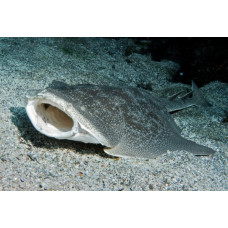Latin name
Squatina japonica
Other name
Squatina japonica
Identification
The Japanese angelshark has a rather slender body and wing-shaped, broad pectoral and ventral fins characteristic of angelsharks. Large oval eyes are widely spaced. Behind the eyes are crescent-shaped spiracles with square protrusions along the inner edge. The large nostrils are framed by small skin folds that end in two antennae. The outer antennae are thin, while the inner one has a spoon-shaped tip and a slightly fringed edge at the base. The skin folds on either side of the head are without pointed lobes. The wide mouth is located at the tip of the snout, with grooves at the corners. There are 10 teeth on each jaw on either side of the symphysis, the tooth on the symphysis is absent. The teeth are small, narrow, and pointed. There are five pairs of gill slits on the sides of the head. The back is covered with medium-sized placoid scales, and a row of large barbs runs along the spine of the body and tail.
Features of fish fins
The anterior edge of the pectoral fins of these sharks forms a triangular projection that is not attached to the head. The outer edge of the pectoral fins is triangular and the posterior ends are rounded. The edges of the pelvic fins are slightly concave. The two triangular dorsal fins are similar in size and shape and are located behind the pelvic fins. The caudal peduncle is flattened and lateral keels are present. The tips of the triangular dorsal fins are rounded. The lower lobe of the caudal fin is larger than the upper lobe.
Fish colouring
The coloration of the Japanese angelshark is light brown, the body is densely covered with square dark spots, the spots covering the fins are shallower. Belly is white with dark markings.
Distribution
Widespread in the northwestern Pacific Ocean from the east coast of Honshu, Japan to Taiwan, including the southern Sea of Japan, Yellow Sea, East China Sea and Taiwan Strait. Early sources indicate that the species occurs in Philippine waters, but recent studies have shown that Squatina caillieti is the only species present in this region.
Habitat
A marine demersal species that prefers subtropical climates. They are found on the continental shelf at depths of up to 300 meters. They prefer to stay on sandy bottoms close to rocky reefs.
Size
The maximum recorded size of this shark species varies from 1.5 to 2.5 meters in different sources.
Behavior
During the day, Japanese angelsharks prefer to lie half-buried on the bottom. Their coloration camouflages them well, allowing them to ambush their prey. At night they become more active. They are found both individually and in groups.
Food and feeding habits
A predator that feeds on benthic animals. Its diet consists of benthic bony fishes, cephalopods and crustaceans.
Reproduction
These sharks reproduce by oviparity. A litter contains 2 to 10 22 cm long newborns. Births occur in spring and summer. Females reach sexual maturity at a length of 80 cm.
Fishing
Japanese angelshark are commonly caught in both directed fisheries and as by-catch in bottom trawls, seines and gillnets.
Relationship with a person
These sharks are usually not dangerous to humans. However, if disturbed, they can bite hard. Their meat is used as food, and their skins are used to make shagreen for polishing wood.
| Classification | |
| Phylum | Chordata |
| Class | Chondrichthyes |
| Squad | Squatiniformes |
| Family | Squatinidae |
| Genus | Squatina |
| Species | S. japonica |
| Features | |
| Conservation status | Critically Endangered |
| Habitat | Bottom |
| Life span, years | No information |
| Maximum body weight, kg | No information |
| Maximum length, cm | 250 |
| Sailing speed, m/s | No information |
| Threat to people | Edible |
| Way of eating | Predator |
Japanese angelshark
Tags: japanese angelshark

